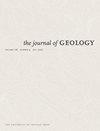东天山晚古生代构造岩浆演化:来自大南湖-罗布泊地区火山岩年代学和地球化学的启示
IF 1.3
4区 地球科学
Q2 GEOLOGY
引用次数: 0
摘要
东天山古生代海洋的最终闭合时间一直存在争议,大地构造学约束仍然很差;因此,晚古生代火成岩的研究对该地区构造史的演化过程具有重要意义。然而,由于东天山晚古生代火山岩的稀有性和识别难度,人们对其关注有限。本文以中亚增生造山带的关键部位——喀拉塔日(沙尔湖)-达南湖-罗布泊地区为研究对象,推进构造岩浆演化研究。晚古生代地层中的火山岩互层,包括火山大厦矿床,主要是流纹岩-火山岩、安山岩/英安岩和玄武岩。这些长英质、中质和镁铁质岩石的锆石激光烧蚀ICP-MS U-Pb年龄为362.5–303 Ma。在地球化学方面,所有样品都具有相似的原始地幔归一化微量元素蜘蛛图和球粒陨石归一化稀土元素图。长英质和中等火山岩属于I型岩石,形成于火山弧中;镁铁质岩石属于拉斑玄武岩系,形成于岛弧(早期)和板内(晚期)。到303±13Ma具有板内玄武岩特征的镁铁质岩石形成时,古亚洲洋已经完全闭合,该地区已进入板内演化阶段。根据火成岩年龄的其他发现和综合分析,古亚洲洋板块的向北俯冲可以较好地解释研究区独特的构造环境与年龄变化趋势之间的关系。从泥盆纪到石炭纪晚期,该过程产生了俯冲、碰撞和碰撞后相关的岩浆作用,310 Ma后,卡拉塔日-达南湖-罗布泊地区同步经历了从俯冲和碰撞到陆内环境的构造转变。本文章由计算机程序翻译,如有差异,请以英文原文为准。
Late Paleozoic Tectonomagmatic Evolution of the Eastern Tianshan, Northwest China: Insights from Geochronology and Geochemistry of Volcanic Rocks from the Dananhu–Lop Nur Area
The final closure time of the Paleozoic ocean in the Eastern Tianshan is debated, and the geotectonics are still poorly constrained; hence, research on late Paleozoic igneous rocks has important implications for the evolutionary processes involved in this area’s tectonic history. However, limited attention has been given to the volcanic rocks in the late Paleozoic strata across the Eastern Tianshan because of their rarity and identification difficulty. This article focuses on the key site of an accretionary orogen in Central Asia, the Kalatage (Shaerhu)-Dananhu–Lop Nur area, to promote the study of tectonomagmatic evolution. The interbedded volcanic rock layers in late Paleozoic strata, including volcanic edifice deposits, are mainly rhyolitic volcanic, andesitic/dacitic, and basaltic rocks. These felsic, intermediate, and mafic rocks have zircon laser ablation ICP-MS U-Pb ages of 362.5–303 Ma. Geochemically, all samples have similar primitive mantle–normalized trace-element spider diagrams and chondrite-normalized rare earth element plots. The felsic and intermediate volcanic rocks are classified as I-type rocks and formed in a volcanic arc, and the mafic rocks belong to the tholeiite series and formed in island arc (earlier) and intraplate (later) settings. By the time the mafic rocks with intraplate basalt characteristics formed at 303±13 Ma, the Paleo-Asian Ocean had completely closed, and the region had entered the intraplate evolution stage. On the basis of other findings regarding the ages of igneous rocks and synthetic analysis, the northward subduction of the Paleo-Asian oceanic slab can preferably explain the relationship between the distinctive tectonic environment and the age variation trend in the study area. The process generated subduction-, collision- and postcollision-related magmatism from the Devonian to the late Carboniferous, and after 310 Ma, the Kalatage-Dananhu–Lop Nur area synchronously underwent a tectonic transition from subduction and collision to an intracontinental environment.
求助全文
通过发布文献求助,成功后即可免费获取论文全文。
去求助
来源期刊

Journal of Geology
地学-地质学
CiteScore
3.50
自引率
5.60%
发文量
0
审稿时长
3 months
期刊介绍:
One of the oldest journals in geology, The Journal of Geology has since 1893 promoted the systematic philosophical and fundamental study of geology.
The Journal publishes original research across a broad range of subfields in geology, including geophysics, geochemistry, sedimentology, geomorphology, petrology, plate tectonics, volcanology, structural geology, mineralogy, and planetary sciences. Many of its articles have wide appeal for geologists, present research of topical relevance, and offer new geological insights through the application of innovative approaches and methods.
 求助内容:
求助内容: 应助结果提醒方式:
应助结果提醒方式:


